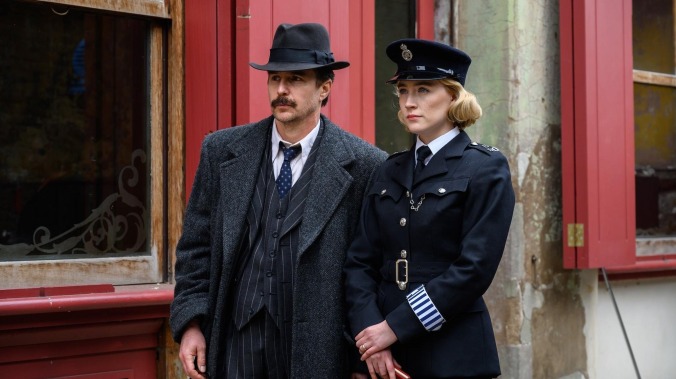See How They Run asks Sam Rockwell and Saoirse Ronan to solve only murders in the theater
Director Tom George's meta-spoof highlights the conventions of whodunits instead of simply solving who done it

See How They Run is the latest in a string of films that have attempted to bring the whodunit into the 21st century, following Kenneth Branagh’s Poirot films and Rian Johnson’s breakout hit Knives Out. Director Tom George and writer Mark Chappell skew closer to Johnson’s subversive glee than Branagh’s high theatrics, but for all of its self-aware, comic trappings, their film doesn’t have much to say about its genre besides the obvious.
Acerbic film director Leo Köpernick (Adrien Brody) sets the tone early, cynically describing the whodunit formula in voiceover while setting the scene for what audiences prepare to watch. In the West End of London in 1953, a stage production of Agatha Christie’s The Mousetrap reaches its 100th performance, and among the celebrants are parties interested in adapting the play into a film. However, as Köpernick explains, a hallmark of murder mysteries is that the most unlikeable character is the one bound to be killed first—so it comes as little surprise that his body that is the one found on stage.
This draws the attention of world-weary police Inspector Stoppard (Sam Rockwell) and his overeager protege, Constable Stalker (Saoirse Ronan), who interview suspects. Whether it’s an effeminate screenwriter (David Oyelowo) who hated Köpernick’s proposed changes to the narrative, a blackmailed producer (Reece Shearsmith), or any of the play’s charismatic cast (including Harris Dickinson as Richard Attenborough and Pearl Chanda as Sheila Sim), virtually everyone has a reason to want Köpernick dead.
The tongue-in-cheek tone of Köpernick’s pre-mortem narration matches the rest of the film’s comedic sensibilities, which deliver a self-aware commentary about the tropes and staples of its chosen genre. Not only is this accentuated with a stylistic use of split-screen cinematography and snappy editing, but its investigative leads act as cornerstones of genre convention and a reflexive study of those conventions.
Stoppard epitomizes the archetypal detective whose personal life revolves around the central pillars of depression and alcoholism, while Stalker acts primarily as an audience surrogate, jumping to conclusions based on Stoppard’s investigative interviews, which he then has to rein in as insufficiently supported by evidence or logic. Rockwell’s performance is perhaps a bit too reserved to make the buddy pairing totally gel, but Ronan makes up for it with a self-deprecating spunkiness, leaning into the inherent absurdity of whodunit deductive reasoning.
However, the more See How They Run emphasizes its knowledge of mystery fiction, the more apparent it becomes that the film has little to actually say about it. Unlike Knives Out, where the twists and turns of the story are compelling in their own right while simultaneously flipping conventional framing on its head, See How They Run is content to fill its screenplay with explicit observations about red herrings and cinematic conventions such as flashbacks and title cards while being a story that relies heavily on such tropes.
Once the shallowness of that central joke becomes apparent, it leaves the film in an uncanny lurch, where the silly atmosphere and occasional physical gag are endearing, but less clever than advertised. In fact, its attempts at faux subversion undercut the tension of the mystery, as a second act investigation is so heavily telegraphed as a dead end that the audience becomes impatient for the other shoe to drop.
All of which is a shame, because as a straight-faced whodunit, See How They Run could be a worthy successor to the legacy of Agatha Christie. The actual resolution to the mystery is not so easily deduced, but the seeds are sufficiently planted for the killer’s identity to not only make sense, but to be far more compelling than any of the established red herrings. And while the light tone is mainly present to make the comedy palatable, it still works as a farcically surreal take on mystery storytellers being caught up in a murder mystery all their own.
Ultimately, See How They Run is too reverent to its forebears and too toothless in its satire to elevate beyond an overly self-aware genre exercise—competent enough, but all too eager to shoot any attempted subtlety dead where it stands.